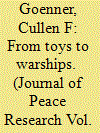|
|
|
Sort Order |
|
|
|
Items / Page
|
|
|
|
|
|
|
| Srl | Item |
| 1 |
ID:
100390


|
|
|
|
|
| Publication |
2010.
|
| Summary/Abstract |
The United States recently proposed to sell Saudi Arabia advanced weaponry worth 20 billion dollars over the next 10 years. The volume of trade, while significant, is second in the news headline that the United States would provide Saudi Arabia with precision-guided bombs, upgrades to its fighters, and new naval vessels. Trade of strategic commodities, such as armaments, suggests a strong interdependence between countries, which may influence international relations differently than the same volume of toys traded between nations. The author posits the volume and pattern of commodities that countries trade with each other are both relevant to interstate conflict. Commodities are heterogeneous and thus vary in terms of their strategic importance, substitutability, and ease of expropriation. This heterogeneity, along with the volume of trade, influences the opportunity cost of lost trade caused by conflict. This article empirically examines whether the pattern of trade is relevant to conflict for the period 1962-2000. The results from both single and simultaneous equations models indicate that increasing the share of bilateral trade in energy, non-ferrous metals, and electronics increases conflict, whereas for chemicals and arms it reduces conflict. Differences in these strategic commodities' elasticity of import demand and export supply, along with their ease of expropriation, contribute to the heterogeneous effects.
|
|
|
|
|
|
|
|
|
|
|
|
|
|
|
|
| 2 |
ID:
088204


|
|
|
|
|
| Publication |
2009.
|
| Summary/Abstract |
In China, Energy Efficiency Retrofit for Existing Residential Buildings (EERFERB) is faced with a fast development status. The Central Government decided to prompt the retrofit of 1.5×108 m2 existing residential buildings in China's northern heating region during the "11th Five-Years Plan". But, at present, the relative incentive policies and measurements are very insufficient. Especially, on the aspect of the retrofit pattern about the organization, retrofit content, investing and financing mode, the policy and management and other factors, no existing successful one can be spreaded into the whole northern heating region. This research not only analyzed the foreign advanced methods, drew lessons from their retrofit in Germany and Poland, but contrasted and analyzed energy efficiency retrofit demonstrations from Harbin, Tianjin, Tangshan and Baotou in China to get our domestic successful patterns and experience. Finally, some recommended retrofit patterns are presented, which can be applied for the instruction and decision-making for the Chinese local governments.
|
|
|
|
|
|
|
|
|
|
|
|
|
|
|
|
| 3 |
ID:
150877


|
|
|
|
|
| Summary/Abstract |
The USA is a leading country while China is an up-and-coming one in nanotechnology. We carried out a cross-country comparative study on policy and innovation of the two countries in subset nanoenergy field. They both created favorable policy environments for nanotechnology involving applications of nanotechnology in the energy sector. However, Chinese policy deployments for nanotechnology lack coordinated arrangements and effective assessment mechanisms. China performs better than the USA in technological quantity, but weaker in technological influence. The USA expresses an industry-oriented model in nanoenergy technological research and development, but China exhibits a university-and-institute-oriented model. Interorganizational collaboration relationships in the two countries are both still very rare and have huge development space. They both have a long way to go in converting their technological achievements into commercial products, especially China. Finally, we provide the policy implications of this study. In particular, the Chinese government should strengthen its efforts in policies by changing the national S&T evaluation system to set up the basic idea that quality is better than quantity in order to raise the original innovation motivations of innovators.
|
|
|
|
|
|
|
|
|
|
|
|
|
|
|
|
|
|
|
|
|